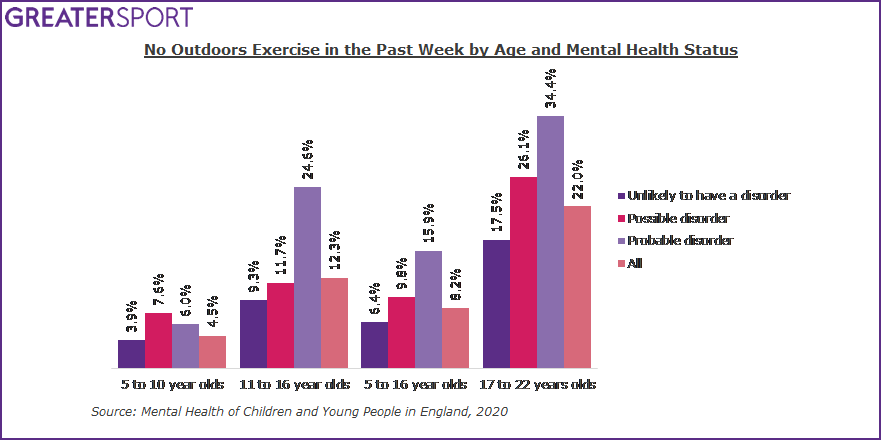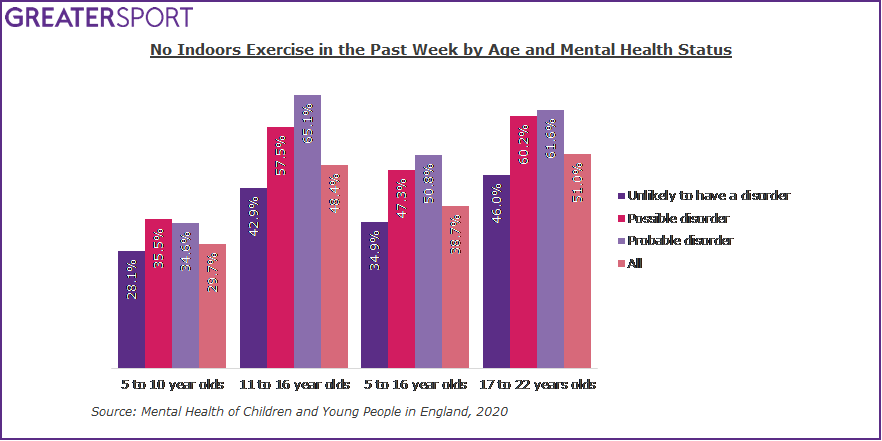Mental Health of Children and Young People in England, 2020
The latest research has found the rates of probable mental disorders have increased since 2017. In 2020, one in six children aged 5 to 16 years were identified as having a probable mental disorder up from one in nine in 2017.
One in six (16.0%) children (5 to 16 year olds) were found to have a probable mental disorder which increases with age. Amongst young people, (17 to 22 year olds) one in five (20.0%) were identified as having a probable mental disorder; there is also a noticeable gender difference in the prevalence of probable mental disorders with 27.2% of young women and 13.3% of young men.
Probable mental disorders are also higher than the national average in our region with 16.6% of 5 to 16 year olds in the North West with a probable mental disorder.
One in ten, 10.1%, of 11 to 22 year olds said that they often or always felt lonely, this was more common amongst those with a probable mental disorder. The gendered dynamic was visible once more with 13.8% of girls and 6.5% of boys reporting loneliness.
Contact with services regarding mental health issues was found to be more common amongst 17 to 22 year olds with 20.2% requiring access to these services compared to 11.4% of 5 to 16 year olds. During the pandemic, March to July, 7.2% of young people were able to continue to access services as normal, compared to just 3.6% of children. were twice as likely to have received help from services as normal (7.2%) than children. However, young people were more likely to have tried to seek help and not received the required support compared to children; 7.4% vs 3.8%.
Physical Activity
What is particularly concerning is the differences in activity levels amongst those believed to have a mental disorder and those without, particularly amongst older children and young people. Amongst 11 to 16 year olds and 17 to 22 year olds those with a probable mental disorder are approximately twice as likely to have not partaken in any outdoors exercise; 2.10 and 1.97 times respectively.

Whilst the disparity between those unlikely to have a disorder and those with probable disorder is not as profound when it comes to indoors exercise there is still a clear difference amongst older children and young people. The gap varies from 6.5% amongst 5 to 10 year old and rises to 22.2% amongst 11 to 16 year olds.

Parent and child anxieties about Covid-19, and well-being
Anxiety about Covid-19 amongst 11 to 22 year olds varies by age (higher levels amongst 17 to 22 year olds) and gender (girls are more likely to be anxious). Those with a probable mental disorder were also more likely to experience anxiety about the pandemic.
Parents of 5 to 16 year olds identified what they thought their child was most anxious about with regard to the pandemic as ‘worries about missing school/work’ (37.7%) and concerns about ‘friends and family catching Covid-19’ (36.7%). It is important to note that worries about school and work were similar amongst those unlikely to have a disorder (37.4%) and those with a probable disorder (38.7%).
Meanwhile, three quarters (75.0%) of parents themselves were worried about their child missing out on meeting their school friends and 68.0% were concerned about them missing school or work.
We know that physical activity has a key role to play in mental health with the Active Lives Children and Young People survey finding that children and young people who are active have higher levels of life satisfaction and viewing life as worthwhile. Meanwhile, sedentary behaviour amongst young people has also been found to be associated with depressive symptoms.
Published October 2020
